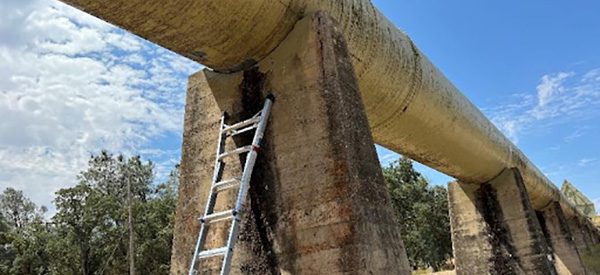
Case Study | OEHS

NES Performs Environmental Sampling of Aqueduct
NES performed comprehensive environmental samplings of crossing and wasteway coatings in order to identify potentially hazardous materials that will be disturbed during a recoating project for consideration of worker safety and management of future wastes.
NES helped the client characterize the coatings along the aqueduct by identifying hazardous materials that would be disturbed during the recoating project, the formation of which will be used by the contractor to protect the health and safety of workers and ensure proper disposal of wastes.
Industry: Utilities
Company Size: 1,759 Employees
Location: Calaveras County, San Joaquin, Contra Costa County
The Challenge
The approximately 90-mile Aqueduct originates near Campo Seco in Calaveras County and terminates in Walnut Creek, Contra Costa County, delivering water to treatment facilities in the San Francisco Bay Area.
The Aqueduct is largely subterranean, with 56 gully crossings (crossings) and two wasteway relief pipes (wasteways) in the low-lying topographical areas. Each crossing is anchored on concrete or metal bents for support. Over the years, the original crossings installed circa 1927, with an exterior coating of a bitumastic coal tar enamel have been recoated with latex enamel for corrosion protection from environmental elements. The wasteways have a cement-mortar coating.
The crossings and wasteways are scheduled to be recoated in 2023. The client retained NES to perform environmental sampling of crossing and wasteway coatings in order to identify potentially hazardous materials that will be disturbed during the recoating project for consideration of worker safety and management of future wastes.
The NES Solution
NES participated in numerous client calls providing their expertise prior the commencement of the project. The three and a half weeks of environmental surveying performed by NES consisted of a visual inspection of each crossing and wasteway location to evaluate the homogeneity of the coating material at each sampling location, and bulk sample collection at 56 crossing and two wasteway locations for Title 22 California Administrative Manual (CAM 17) regulated metals, polychlorinated biphenyls (PCBs), semi-volatiles organic compounds (SVOCs), polycyclic aromatic hydrocarbons (PAHs), and asbestos analyses. The sampling was performed in July and August of 2022 (the hottest months of the year!)
The work was carried out under adverse physical and environmental conditions, and under rigid time constraints. The hazards faced by the qualified and exceptionally dedicated NES team performing the sampling not only included the potential chemical contaminants in the coating being sampled, but also biological hazards (snakes, poisonous plants, biohazard) and physical hazards (extreme heat, slips/trips/falls, sampling tool injuries).
Once the sampling was finished, the team prepared a report of findings that identified the hazardous materials and provided recommendations for compliance.
NES helped the client characterize the coatings along the aqueduct by identifying hazardous materials that will be disturbed during the recoating project. This is formation will be used by the contractor to protect the health and safety of workers and ensure proper disposal of wastes.
